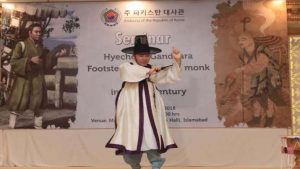Written by Dahui Zonggao and translated by Thomas Cleary (1949–2021), one of the most prolific translators of Buddhist works and Asian classics in recent history (including the enormous undertaking of the Avatamsaka Sutra (or Flower Ornament Scripture) amounting to more than a massive 1,600 pages), The Treasury of the Eye of True Teaching: Classic Stories, Discourses, and Poems of the Chan Tradition is also a “massive compilation.” In this case, a collection of Chan works used by the master teacher Dahui Zonggao (1089–1163). More than 650 installments. Truly massive in fact.
Dahui himself revived enthusiasm for Chan practice during China’s Southern Song dynasty (1127–1279), and he was known for teaching the ineffable in ways outside of conventional mental constructs. As explored within the pages of this compendium, how can the ineffable be explained with words? And so many words! Try to explain, and we fail. However, what we we can do is offer a challenge to the rational brain: let it ruminate until the knowing mind unlocks the stiff bolts of fixed egoic thinking and opens the doors to luminous awareness. And that’s what the commentaries of Chan lore—these verses—aim to do. These many many words prod and poke our oh-so-clever brain until intuition eventually blooms.
One thousand monks, one thousand religions, as they say.
At one point while reading, I asked myself: what am I reviewing? Thomas Cleary’s translation? The way it’s been compiled? The wisdom of Dahui himself? The myriad masters from antiquity quoted in Dahui’s lessons? The root texts of the collection of Chan Buddhist koans, the Blue Cliff Record, compiled by Dahui’s master, Yuanwu Keqin? Who am I to judge? So I offer you my thoughts as they arose while I immersed myself in the wisdom of deep history, which couldn’t be more relevant today.
It seems that the lessons don’t change as the human condition really doesn’t appear to have changed much either. And yet modern science is only just quantifying what was known so long ago; that this is all an illusion. For modern folk like us, unlike the polite conversation that we may be used to hearing from contemporary wisdom teachers, these patriarch stories use a blunt, if not crass, lexicon to beat us with verbal bamboo sticks. This is not violence for the sake of violence—although the number of actual beatings apparently issued and suggested by the masters seems pretty brutal—the discourses were designed to beat delusion out of us. But just as we think we’ve finally got it, the Chan master will bamboozle us again. Especially if the piousness of religious ego enters the fray.
There is a scene in the 2004 movie Ocean’s Twelve, with which some of you may be familiar. A neophyte to the group wants more responsibility and to be taken more seriously. He feels ready. So the group “elders” permit him to join a meeting, where he is thrown into the deep end, utterly lost and confused as the two elders discourse in a language even more confusing and nonsensical than “yodish.”* When all eyes are on him to join in, he fumbles within his brain for something to say, and the best he can come up with are the lyrics to a well-known song. He was then unceremoniously removed from the meeting. Of course, he was set up: the pseudo-discourse was utter gibberish, but it was a lesson. It was a brutal and humiliating lesson intended to knock the lad off his overeager, self-aggrandise pedestal.

And Chan discourses remind me of this, or should I say that this scene reminds me of Chan teachers and neophytes. In Chan, the “yodish” may sound nonsensical to the unenlightened mind, but it is far from gibberish. But many might respond by quoting the equivalent of a well-known song. And how many self-appointed “gurus” woo the naive with the same impressive-sounding “song lyrics”? Their prey the enlightenment seekers today, donning their malas, memorizing the mantras, and racing to the East.
As Dahui stated all those years ago: “Nowadays, students take a little bit of diligence, bowing to the Buddha, recitation, and discipline of conduct, speech, and thought for fodder to seek realization. What connection is there? They’re much like ignoramuses burying their heads running westward to get something in the east. The more they run, the further away they are; the more they hurry, the later they are. This is a great teaching with no contrivance, no affectation, and no effort; if you arouse the slightest thought of getting realization, you run away from it. How can you hope to seek it by a little bit of contrived practice?”
So we are poked with a bamboo stick by the masters until we enlighten our minds with knowing intelligence rather than fumbled-for cleverness. And here, as a side note, I note the curious thing that these teachings all come from those known as patriarchs, rather than from women of the day. After all, women are, generally speaking, more inherently in tune with the teachings of Chan than most men. And maybe that’s the point? (In the coming months however, I shall be reviewing Yin Mountain: The Immortal Poetry of Three Daoist Women, which may offer us interesting insights). The masculine brain (this is different from, but typical to, the male gender) wants to organize, rationalize, strive and achieve, conquer and dominate. These can be good things in the appropriate context and often quite necessary in life, but not so much in Chan:
When you get the meaning and forget the words, the Way is easy to draw near.
When all is said and done, the essence of Chan—like Zen, like Daoism, like Sufism, gnosticism, Sikhism, and Hinduism—urges us to let go of the cleverness, the impressive lyrics, the clinging, the masks, the competition, the striving, the selfish desires, the searching, the illusion of self, the ascension as a something to aspire to . . . instead to simply be: be in the awareness of being alive in this moment; no desire to acquire, to conquer, to manipulate. Relax into the now.
The masters remind us that we must all breathe, eat, defecate, and sleep. We take care of the business of being in this temporary meat sack, but we should not lose sight of fundamental reality: that none of it is real and you are not real because none of this inherently exists.
Each of the 668 “verses” in this book require time to digest. But once we shift our mental state from rational processing (masculine brain) to lateral thinking (feminine brain), to intuit poetically or even pictorially, then we are more able to derive what is actually imbued in the words.
“Where do you come from?” seems to have been a common exploration as it appears in many verses, but I began to wonder if this question was really geographic. The rational brain answers with the name of a place. Was it actually more akin to the question “where are you coming from and where are you going?” It’s not about location at all. Where are you coming from and where are you going with these lessons? What do you hope to achieve?
Historically, without a doubt, this book is a treasure trove of dedication by everyone involved, spanning millennia. This is a treasure box of wisdom; a reference-worthy piece of history for safeguarding, yet I do not believe that being a student of Chan is a prerequisite for owning and deriving wisdom from its pages.
Is it a coffee table read or a start-to-finish kind of book? To sit and read one discourse after another may feel like a relentless hammering to the intellect. And for some, that may be a useful way to proceed. But for most of us, this is a wonderful resource that, like many koans, can also act almost as an oracle. Leaf through the pages and arbitrarily let your eyes rest on one and dwell on its wisdom. One thousand monks, one thousand religions. In this case, it’s one reader, 668 verses. At least one of them will be the appropriate hammer that breaks through your personal intellectual wall and allows for the experience of the “eureka moment.”
It is to his utmost credit that the translator, Thomas Cleary, had honed his craft as well as he did. This classic compendium, fundamental to Chan Buddhism, reads beautifully, with complex texts and profoundly subtle meaning. Cleary ensures that the reader is aware of any wordplay, which was so often used, with footnotes, translator narrations, and of course Dahui’s own commentary, which is evident among the play-like discourses.
What more is there to say? To us all is silently held a flower.**
This is the living door; only when you have the action of views die out can you enter.
(Dahui Zonggao)
* Chan masters, like Japanese Zen masters, were arguably the precursors of “yodish,” a neologism for the language pattern of the Star Wars character Yoda.
** To those who had gathered to hear the Buddha speak, he held up a flower and said nothing until his disciple Kasyapa the Elder smiled. Then he spoke: “I have the treasury of the eye of true teaching, the ineffable mind of nirvana, the most subtle of teachings on the formlessness of the form of reality. It is not defined in words, but is specially transmitted outside of doctrine.”
References
Dahui Zonggao. 2022. Treasury of the Eye of True Teaching: Classic Stories, Discourses, and Poems of the Chan Tradition. Translated by Thomas Cleary. Boulder, CO: Shambhala Publications
See more
Treasury of the Eye of True Teaching (Shambhala Publications)
Related features from BDG
Book Review: That Is Not Your Mind! Zen Reflections on the Surangama Sutra
Book Review: Talking Zen by Alan Watts
Book Review: Zen Master Tales: Stories from the Lives of Taigu, Sengai, Hakuin and Ryokan















Wy does the title of the article say “The Treasury of the Eye of True Meaning” When the cover of the book says “The Treasury of the Eye of True Teaching”?